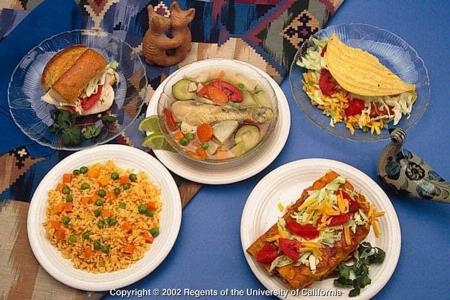In the United States, Latinos account for 15 percent of the population, more than 47 million in all, but you can’t paint their impact on U.S. culture with a broad brush – especially when it comes to food. The Latino population is culturally and ethnically diverse.
Differences between Mexico, Puerto Rico and other Latin American countries stem from 500 years of separate histories, diverse native populations and their customs prior to the arrival of Spanish explorers. In order for nutrition educators to help Latinos maintain a healthy diet, messages should be tailored specifically to the Latino population residing in the particular geographical area.
In California, more than 80 percent of the Latino population is of Mexican descent. The Mexican diet is a blend of pre-Columbian, indigenous Indian, Spanish, French, and recently, American culture. Typically, the Mexican diet is rich in complex carbohydrates, which are provided mainly by corn and corn products, usually tortillas, present at almost every meal, beans, rice and breads. The diet also contains protein from beans, eggs, fish and shellfish, and a variety of meats, mostly pork and poultry. Traditional diets also reflect the geographic regions of Mexico and the availability of local fruits, vegetables, grains and dairy products.
There are simple ways to make traditional Mexican dishes healthier. Following are seven suggestions based on the 2010 American Dietary Guidelines:
- Substitute refried beans with whole black beans or pinto beans. Serve boiled beans instead of refrying them. For flavor, add spices like laurel leaves and other traditional spices.
- For refried beans, substitute lard, butter and shortening with olive oil or vegetable oil. These oils are free of trans fats and contain unsaturated fats, which help prevent cardiovascular disease by inhibiting the buildup of cholesterol in the body.
- Bake your own chips and use whole wheat tortillas to make them crispy and flavorful. This will reduce fat and calorie content.
- Grill or bake instead of frying to reduce the amount of oil you will ingest.
- For toppings, use plain yogurt instead of sour cream. There are some yogurts with the same consistency as sour cream. Add some chipotle, green onion and black olives to give flavor and make it attractive.
- Eat guacamole. Avocado (traditionally known as aguacate or palta) is cholesterol-free and potassium-packed.
- Use more spices – like cumin, peppers, paprika, chili sauces, garlic, cilantro and parsley – instead of salt. Keep salt consumption to less than one teaspoon per day. High salt consumption is linked to increased risk of high blood pressure and kidney disease.
The use of sugar and other caloric sweeteners – such as honey and high-fructose corn syrup – should also be minimized. They contribute to an increased risk of chronic disease, such as cardiovascular diseases and diabetes. The consumption of sugary sodas is very common in the Latino community. Some changes to reduce sugar consumption include:
- Drink water instead of sodas. Add flavor to water by adding mint, parsley, cucumber or lemon slices.
- Drink more aguas frescas; use fruits like pineapple, watermelon, melon, guava, mango. Add some cinnamon for flavor and to reduce the amount of sugar.
- Children should eat cereal without added sugar. Instead they can eat hot cereal and add seasonal fruit like apples, peaches or strawberries.
- Prepare fruits as dessert. Bake apples, serve bananas sprinkled with cinnamon and walnuts, watermelon with chili and lemon, and papaya with lemon.
Attached Images:

Examples of traditional Mexican food.